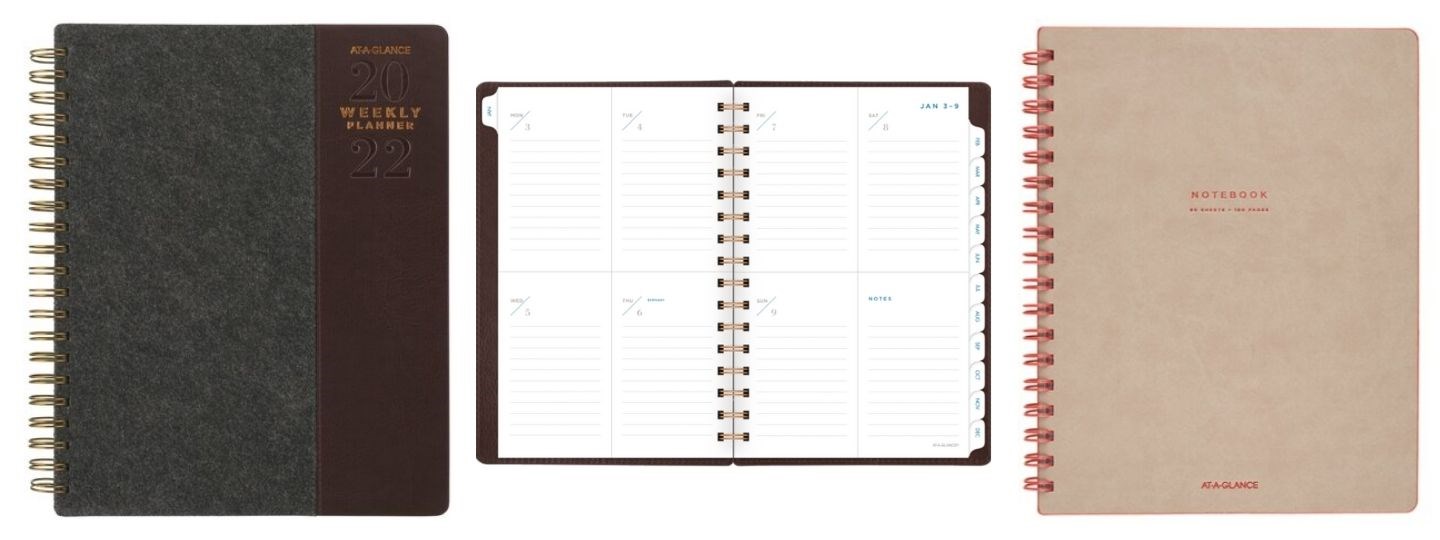
Use your weekly planner to set and accomplish your goals.
Just like that, 2021 is coming to a close. If you are like most people, you’ve had the experience of making a New Year’s Resolution, only to see it crumble by February. It’s much more relevant to set specific goals for the year that are meaningful to you, and to look at them often.
You are probably familiar with our weekly planners, daily planners, and monthly planners, but we also have wall calendars, desk pads, as well as notebooks with the same thick, smooth paper designed specifically for adults. It is helpful to have a system, and not just a planner. Use a wall calendar to keep everyone in your household (or work team) on the same page, a desk pad for visible reminders, and a notebook to organize your whole life, including your yearly goals. For more details on how to use a planning system, see these articles: How to Use a Planner Effectively and Juggling All the Things with My Simplified Planner.
How to Set Meaningful Goals in 2022
Research shows that you are more than 42% more likely to reach goals that you write down.
There are many ways to dig into your heart and mind to discover what lights you up, where your talents lie, and what your goals could be. Here, we present one way to look at all the areas of your life and narrow down to some good, achievable goals for the coming year.
This can be done over a few sessions so that you can devote enough time to each part of this goal-setting process.
1. Clear Your Mind
The first step is to clear your mind. Take a walk in the woods or do whatever clears your mind the best. You want to do this so that you aren’t focusing on all the things you have on your mind for today. You need to expand your life view for this exercise.
2. Brain Dump into a Notebook
Now, this step is just a brain dump of sorts. Don’t judge yourself, and write quickly so you don’t edit yourself.
Take 1-2 minutes to write as fast as you can.
Answer this question: What is most important to you?
Now answer these value questions, trying not to overthink them.
- Who is most important to you?
- What things do you LOVE to do?
- What things would you like to have more time to do?
- What would you like to start doing?
- What things do you have to do?
- Are there activities that you would like to give up that you CAN give up?
3. What Are Your Life Buckets?
Now, look at your life in “buckets.” These are categories of your life that are important, not just things you want to do, but list the things you must do as well.
For example, a working parent might have the following buckets: work bucket, housework/laundry bucket, a family time bucket, a bucket for attending sports and other activities like concerts, a camping/hiking bucket, time with friends, cooking, hobby, volunteering/giving back, spiritual life, etc.
What things matter to you? Take a good look at your buckets. Do they define your life? Who you are? Who you want to be? Where you want to spend your time and effort?
The bucket system is also a good way to declutter, mentally and physically. If you have a closet full of things that don’t fit into your buckets, get rid of them.
Now, when you look at the answers to the questions, and your buckets, is there alignment? If not, spend some time aligning and committing to what areas of life deserve your time.
4. Brainstorm Possible Goals
Now, brainstorm some quick goals that you can refine later. Try to write goals that are achievable. Let’s face it, you aren’t going to change your life overnight. Make sure you are writing goals that connect your answers to the value questions.
For example: If your extended family is important to you, you could make a goal of showing them they are important and that you love them.
If you love hiking, your goal could be hike more next year.
5. Refine Your Goals for 2022
Now, refine your goals, by making sure each goal is worded clearly. Then you’ll need to break that down into objectives and tactics. That is, how you will work toward each goal and how often.
Don’t overwhelm yourself.
For example, to work toward the goal of showing extended family you love them, you may use the tactic of seeing or calling them every two weeks.
For your goal of hiking, just use the objective of one hike per season. Consider it a win if you get one or two hikes in, and celebrate each one. If you get more than four hikes on your calendar, that’s a great thing.
The important point is to set easily achievable goals, and to celebrate each little win.
6. Use Your New AT-A-GLANCE Planning Tools to List, Schedule, and Track Your Goals
Now comes the fun part. Get out your new 2022 planner, calendars, and notebook. In each month, jot down things to do (you can even narrow to your weekly calendar or note in your daily planner if you wish.)
Every month, you will be reminded to do those little things.
Here is an example:
- Go on an outdoor adventure (a hike, etc.) at least once this month.
- Call Uncle Rick twice this month.
- Organize or clean up my closet once this month.
- Have dinner with friends at least once this month.
- Go to at least one concert, movie, or event this month.
- Write in journal (or notebook) at least three times this month.
- Work out at least two times per week this month.
- Contribute socks, underwear, toiletries to shelter once this month.
7. Now, Break Them Down into Smaller Parts and Schedule in Your 2022 Planner
At first glance, it may seem overwhelming, but consider this:
Several of these things can actually be scheduled in your planner.
- Hike
- Call Uncle Rick
- Dinner with friends
- One concert, movie, or event
- Contribute to shelter
The others will just be reminders. You could even make a small checklist in the notes area of your planner or notebook for goals like this:
✅ Clean up closet
✅✅✅ Write in journal
✅✅✅✅✅✅✅✅ Work out
When goals are broken down into smaller parts, they become more easily accomplished.
Next year at this time, you can look back over your goals and happily realize that you have done quite a lot of what you set out to do. You may find that you just easily changed your “ceiling” into a “floor” for next year.
8. Use Your 2022 Planning Tools to Remember Life’s Curveballs and Celebrate Wins.
Every year, we encounter things we couldn’t anticipate (Hello, 2020 Pandemic). Be sure to use your planner or appointment book and notebook to note the things that come at you, and how you handled situations. Writing about things helps us to emotionally process, and also learn from situations. Don’t be hard on yourself and remember to celebrate the smallest of wins.
The Signature Collection of Planners and Notebooks

Stay organized with the sleek AT-A-GLANCE Signature Collection. The neutral palette features a clean, polished look that’s timeless. With an attractive design and ample writing space, the Signature Collection is the perfect complement to your modern, professional style.
Explore our other planning and notetaking collections to find the products that will work best for you. We can also help you narrow it down with these articles: Which Planner is Right for You Based on Your Enneagram Type and Everything You Need for 2022 Planning.
Share Your Experience!
What are your important life buckets? What goals are you attaching to your buckets?
We would love to hear how your goal setting went. It may help other people create their lists by reading your examples.
Share this with family and friends who may benefit, and share on social media, tagging @ataglance please.

